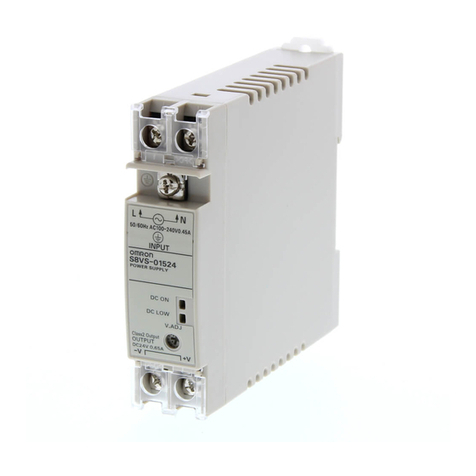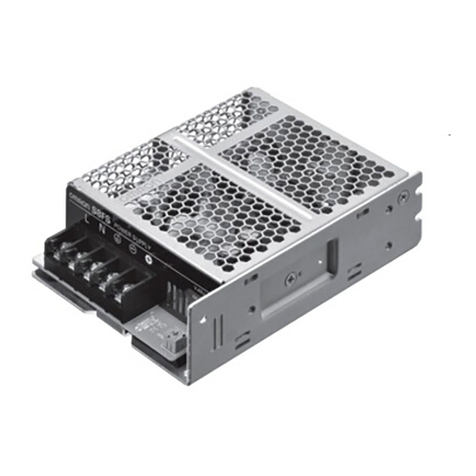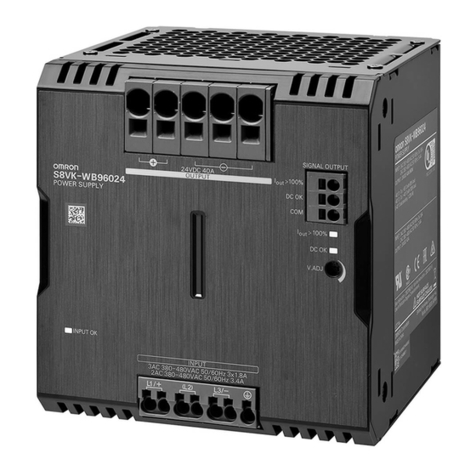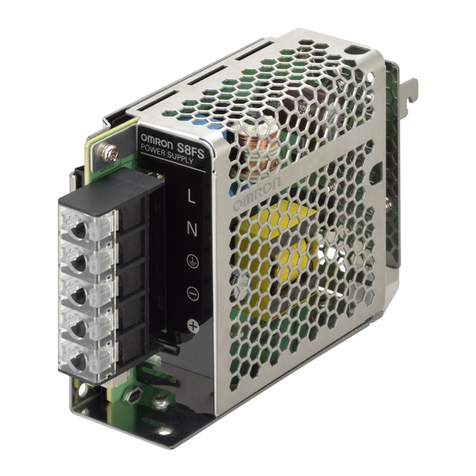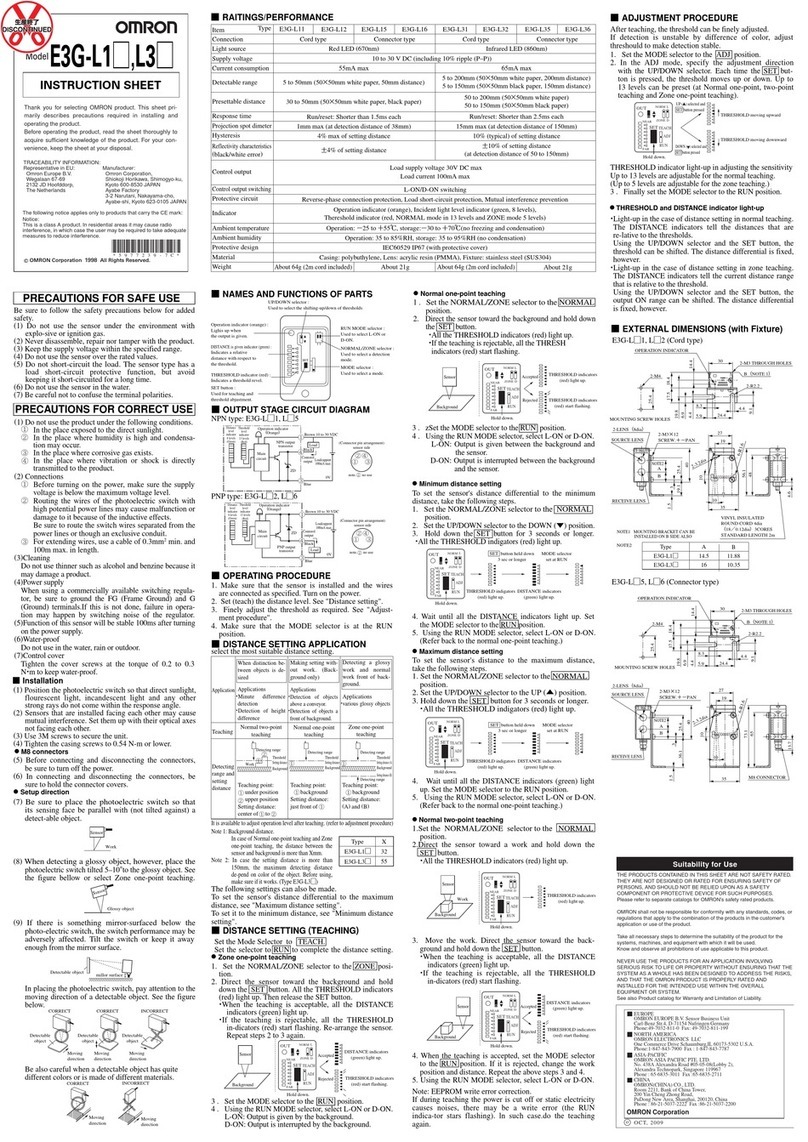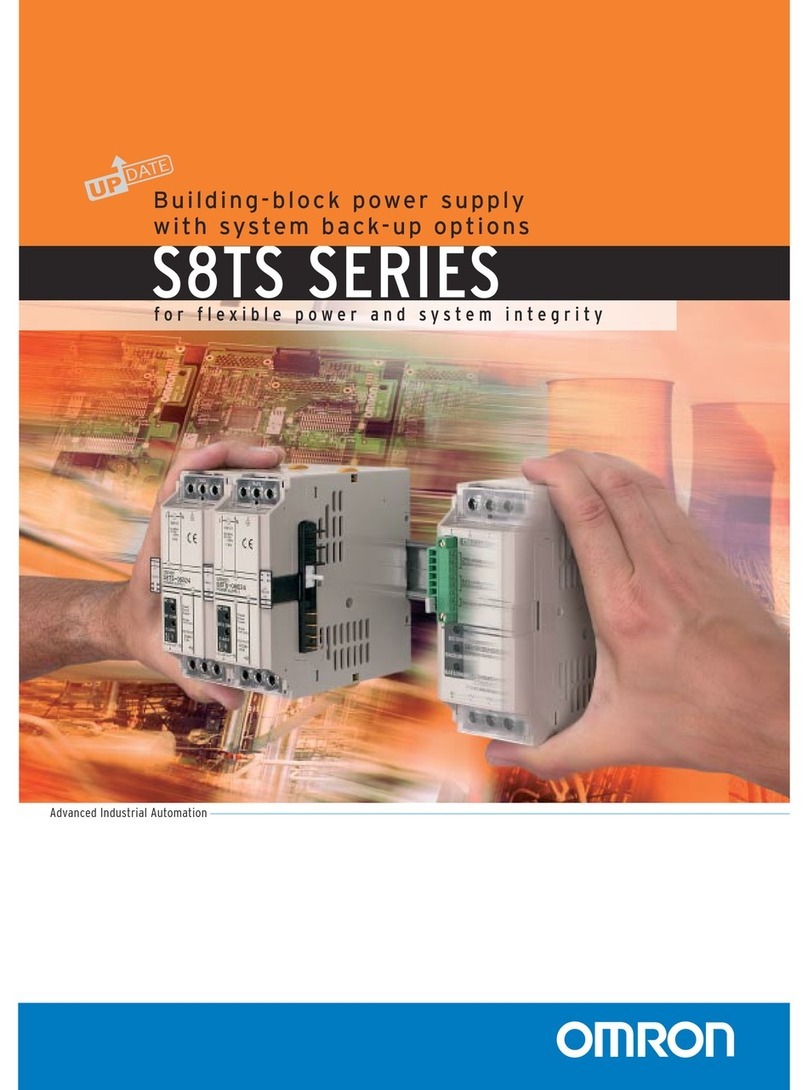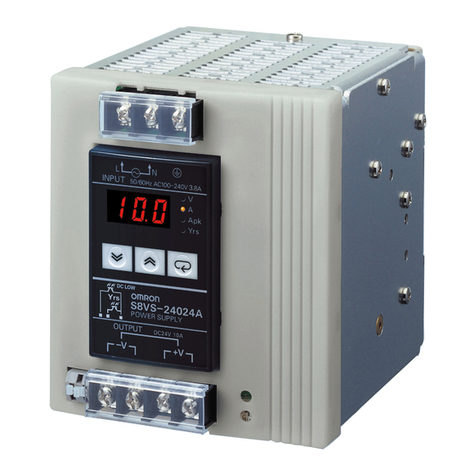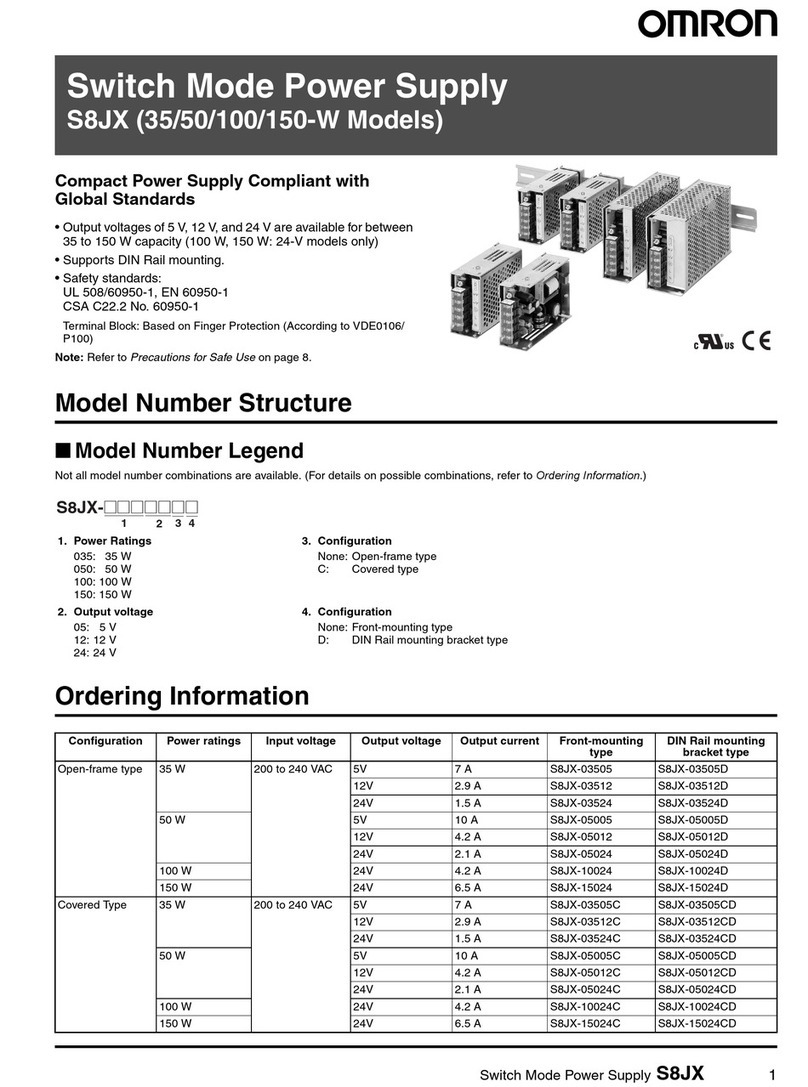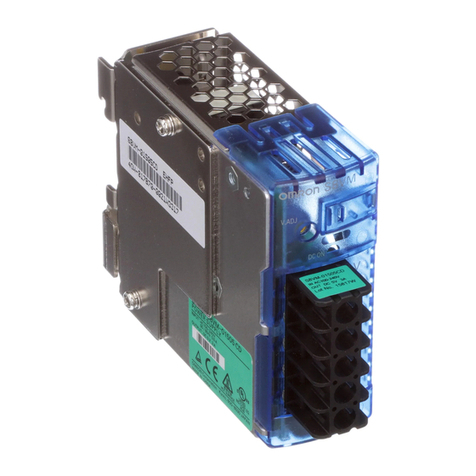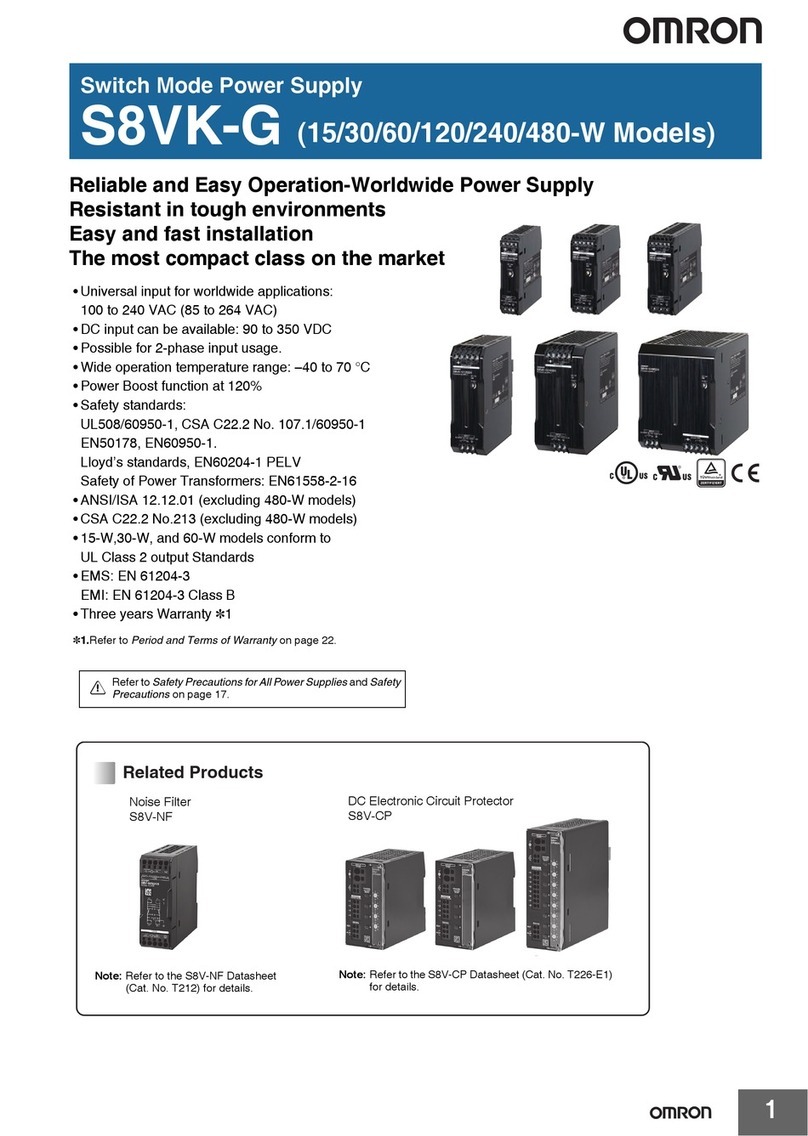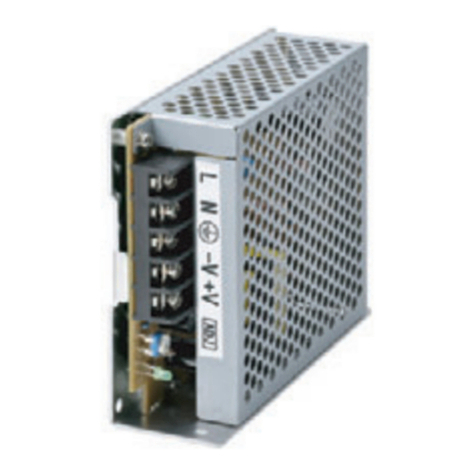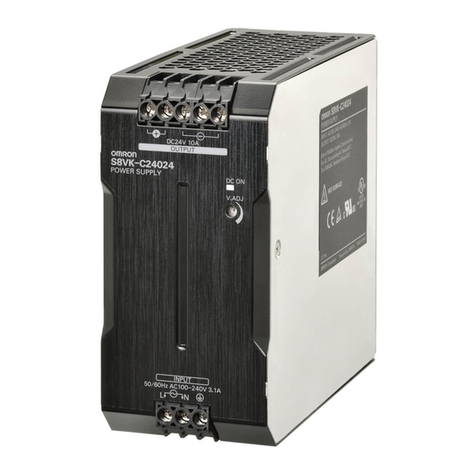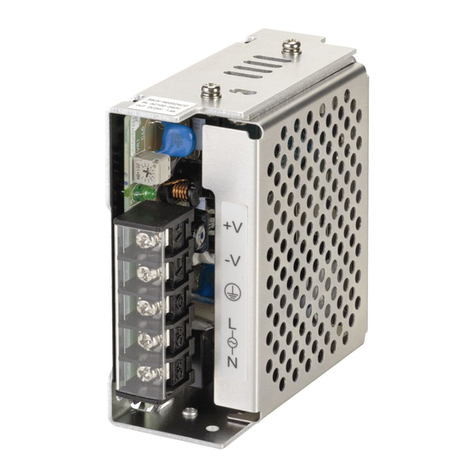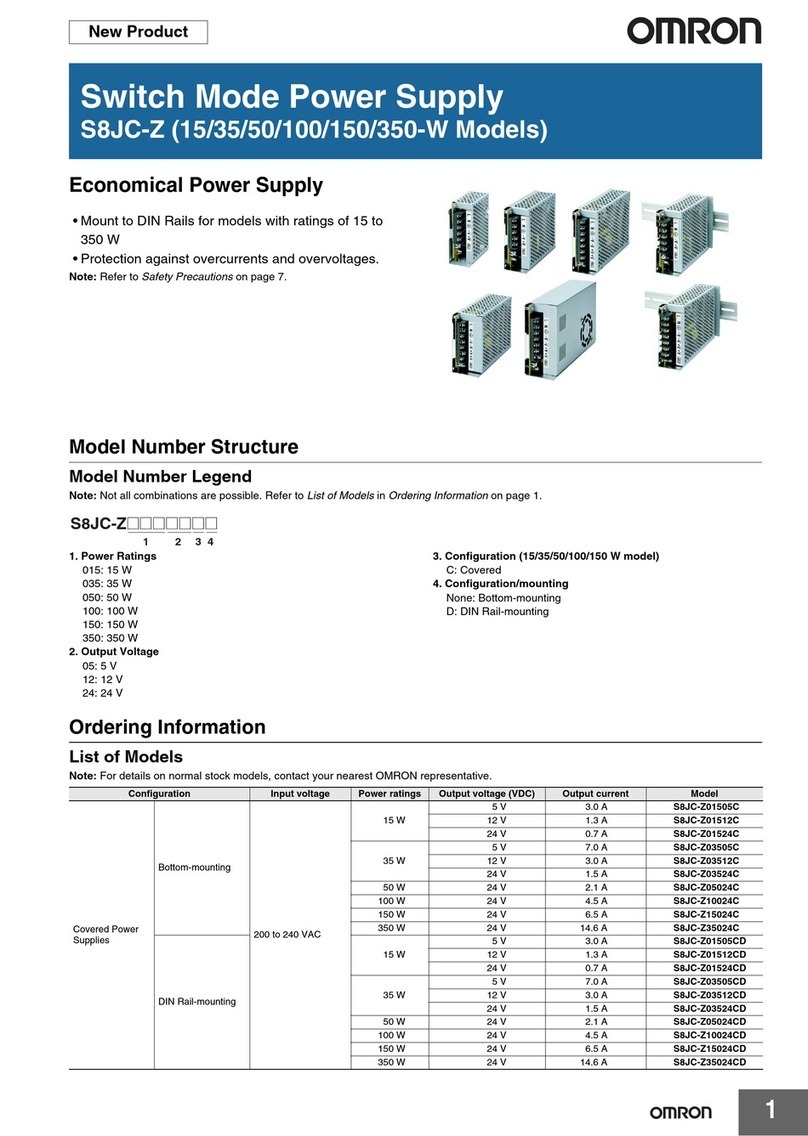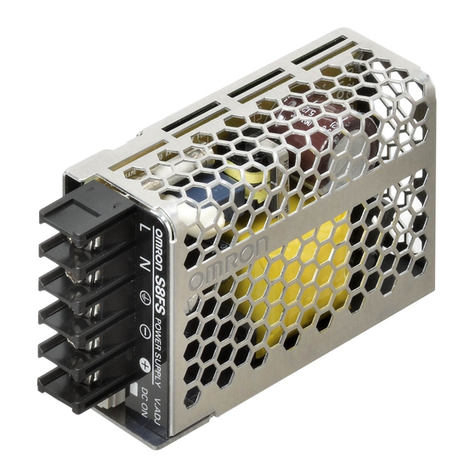
MODEL
S8VK-WA (2000W)
Thank you for purchasing the S8VK-WA.
This Instruction Manual describes the
functions, performance, and application
methods required to use the S8VK-WA.
• Make sure that a specialist with electric
knowledge operates the S8VK-WA.
• Read and understand this Instruction
Manual, and use the Product with enough
understanding.
Keep this Instruction Manual close at hand
and use it for reference during operation.
3621612-8D (Side-A)
INSTRUCTION MANUAL
EN
SWITCHING POWER SUPPLY
Key to Warning Symbols
Warning Symbols
CAUTION
WARNING
Indicates a potentially hazardous situation which, if not avoided, could result in
death or serious injury. Additionally, there may be significant property damage.
Indicates a potentially hazardous situation which, if not avoided, may result in
minor or moderate injury or in property damage.
WARNING
When connecting to the terminal block, insert the wire straight into the terminal block until the
end touches the terminal block.
Otherwise, the wire may come loose, resulting in electric shock.
CAUTION
• If the circuit-breaker trips or the fuse blows, a serious malfunction may have occurred in the
equipment. In that case, do not turn the input back ON.
• Do not allow any pieces of metal or conductors or any clippings or cuttings resulting from installation
work to enter the Product. Doing so may result in minor electric shock, fire, or Product failure.
• Do not touch the terminals while power is being supplied. Doing so may result in minor injury
due to electric shock. Working voltage of 384 V max. is generated inside the Product during
power-ON and remains continuous for 30 seconds after power-OFF.
•
Do not touch the Product while power is being supplied or immediately after power is turned OFF.
Doing so may result in minor burns.
• Do not disassemble, modify, or repair the Product or touch the interior of the Product.
Doing so may result in minor electric shock, fire, or Product failure.
• Be sure to use the recommended circuit-breaker or fuse to avoid risk of fire or electric shock
in case of Product failure. Refer to the Recommended Circuit-breakers and Fuses.
• Do not apply more than 40 N (100 N for the output terminal block) force to the terminal block when you
insert wiring or when you insert a flat-blade screwdriver into the release hole.
• Do not wire anything to the release holes.
• Do not tilt or twist a flat-blade screwdriver while it is inserted into a release hole on the terminal block. The
terminal block may be damaged.
• Insert a flat-blade screwdriver into the release holes at an angle. The terminal block may be damaged if
you insert the screwdriver straight in.
• Do not allow the flat-blade screwdriver to fall out while it is inserted into a release hole.
• Do not bend a wire more than its natural bending radius or pull on it with excessive force.
Doing so may cause the wire disconnection.
• Do not insert more than one wire into each terminal insertion hole.
• Do not pre-solder the ends of the wires. Doing so will inhibit proper connection.
•
If there is a possibility that the Unit will be subject to vibration or shock, use wires with ferrules or stranded wires.
• To allow heat to dissipate, always remove the sheet covering the Product for wiring before you turn ON the power.
Output Voltage Adjustment
• The output voltage adjuster (V. ADJ) may possibly be damaged if it is turned with unnecessary force. Do
not turn the adjuster with excessive force.
• After completing output voltage adjustment, be sure that the output power or output current does not
exceed the rated output power or rated output current.
INPUT OK Indicator
The INPUT OK indicator lights up when the input voltage exceeds the lower limit value of the permissible range.
Note: The voltage may be applied even if the indicator does not light. Be sure to check the input voltage
when performing wiring.
DC OK Indicator/Signal Output
The DC OK indicator lights up when the output voltage is more than 90% of the rated output voltage, and
the internal MOS FET relay is conducted (turned ON).
Note:
• The output voltage may be generated even if the indicator does not light. Be sure to check the output
voltage when connecting to the load.
• The signal output function monitors the voltage of the Product's output terminals. Be sure to measure
the voltage of the load terminal when checking the accurate voltage status applied to the load.
• If the output voltage is set to less than 90% of the rated output voltage, the indicator may go off and the
signal output may be turned OFF.
Iout > 100% Indicator/Signal Output
The Iout > 100% indicator lights up when the output current exceeds the rated output current, and the
internal MOS FET relay is conducted (turned ON).
Specifications of the Signal Output Terminals
(Between DC OK Signal Output Terminal and COM Terminal, and between Iout > 100% Signal Output
Terminal and COM Terminal)
30 VDC max., 50 mA max., residual voltage of 2 V or less at ON and leakage current of 0.1 mA or less at OFF.
Note:
• The Product is not equipped with an internal current limiting circuit. Be sure that the current flowing to
the signal output terminals does not exceed 50 mA.
• Be sure to check that the signal output terminals are working normally after wiring.
See the Product catalog for details.
S8VK-WA202-SPI
S8VK-WA202-SPI*1
S8VK-WA202-SPI
S8VK-WA202-SPI
Input
Output
Signal output/COM
PE (protective earthing)
2.5
6 to 16
0.25 to 2.5
2 to 2.5
14
10 to 6
24 to 14
14
(AWG)(mm2)
Terminal Model Recommend Wire
Precautions for Safe Use
Precautions for Correct Use
•
The derating curve is different from that for standard mounting if the horizontal separation is less than 15 mm.
• The internal parts may occasionally deteriorate or be damaged. Do not use the Product under conditions
that exceed the range of the derating curve.
• Use the Product at a humidity of 95% or less.
• Avoid places where the Product is subjected to direct sunlight.
• Do not use the Product in locations where liquids, foreign matter, or corrosive gases may enter the interior
of the Product.
• Avoid places subject to shock or vibration. Install the Product away from contactors and other parts and
devices that are sources of vibration.
• If the Product is used in an area with excessive electronic noise or surge, be sure to separate the Product
as far as possible from the noise and surge sources.
• The internal parts may occasionally deteriorate and be broken due to adverse heat radiation. Do not
loosen the screws on the Product.
Installing/Storage Environment
• Store the Product at a temperature of −40 to 85°C and a humidity of 95% or less.
•
Take adequate measures to ensure proper heat dissipation to increase the long-term reliability of the Product.
The Product is cooled by natural convection. Mount it in such a way that the surrounding air around the
Product is convected.
Installation/Wiring
• Connect the ground completely. A protective earthing terminal complied with safety standards is used.
Electric shock or malfunction may occur if the ground is not connected completely.
• Minor fire may possibly occur. Ensure that input and output terminals are wired correctly.
• Minor fire may possibly occur. When replacing with the Product, be sure to check the equipment voltage
and use the appropriate Product.
• To prevent wiring materials from smoking or ignition, confirm wire ratings and use the wiring materials
given in the following table.
Recommend Wire:
Stripping length
Recommended Circuit-breakers and Fuses
• Be sure to use the recommended circuit-breaker or fuse to avoid risk of fire or electric shock in case of
Product failure.
• To comply with safety standards and to ensure safety when using the Product, be sure to use the
following recommended circuit-breakers or fuses to connect the input to the Product.
• Connect the input as shown in the figure of Power Distribution System.
• A circuit breaker or fuse can be changed only by a fully trained or skilled operator.
Single-phase
DC
Model Input Recommended Items (per one Product)
S8VK-WA202-SPI
EN/IEC 62477-1 and EN/IEC 61204-7
• DC output terminals (➇to ⑭) are electrically
isolated from the input terminals (➀to ➅).
•
Overvoltage category III (≤ 2,000 m)
Overvoltage category II (2,000 m < and ≤ 3,000 m)
• This equipment is for protection class I.
• Climatic class 3K3
Do not handle the S8VK-WA20248-SPI with wet
hands.
CSA C22.2 No.107.1
CAUTION: FOR USE IN A CONTROLLED
ENVIRONMENT. REFER TO MANUAL FOR
ENVIRONMENTAL CONDITIONS.
ATTENTION: POUR UTILISATION EN
ATMOSPHÈRE CONTRÔLÉE. CONSULTER LA
NOTICE TECHNIQUE.
Ambient temperature / Surrounding Air
Temperature
Max. 55°C at 80% load, 40°C at 100% load
(> 40°C Load derating: 1.33%/K)
Pollution degree
Use in pollution degree 2 environment.
DC Input
• Safety standards apply for a DC input with
EN/IEC 62477-1 and EN/IEC 61204-7.
• Input voltage: 240 to 384 VDC (< 280 VDC load
derating: 1.0%/V)
Conformance to RCM
The Power Supply complies with RCM as an
industrial device.
BCP (Branch Circuit Protection)
This Product has been certified and conformity
assessed by test with the following BCPs:
Eaton Electrical Ltd., FAZ-D40/3-NA, 40 A 240 VAC
(UL certified CCN: DIVQ/7)
Safety standards
Removing Wires from Push-In Plus Terminal Block
Use the following procedure to remove wires from the terminal block.
The same method is used to remove stranded wires, solid wires, and
ferrules.
1.
Hold a flat-blade screwdriver at an angle and insert it into the release hole.
2. Remove the wire from the terminal insertion hole while inserting the
flat-blade screwdriver into the release hole.
3. Remove the flat-blade screwdriver from the release hole.
Recommended Flat-blade Screwdriver
Use a flat-blade screwdriver to connect and remove wires.
Use the flat-blade screwdriver shown below.
Input terminal block/PE terminal block
Output signal terminal block/COM terminal block DC output terminal block
● Connecting Stranded Wires
Use the following procedure to connect the wires to the terminal block.
1.
Hold a flat-blade screwdriver at an angle and insert it into the release hole.
The angle should be between 10° and 15°.
If the flat-blade screwdriver is inserted correctly, you will feel the
spring in the release hole.
2. Insert the wire until it strikes the terminal block while inserting the
flat-blade screwdriver into the terminal hole.
3. Remove the flat-blade screwdriver from the release hole.
Connecting Wires to the Push-In Plus Terminal Block
● Connecting Wires with Ferrules and Solid Wires
Insert the solid wire or ferrule straight into the terminal block until the
end strikes the terminal block.
If it is difficult to connect a wire because it is too thin, use a flat-blade
screwdriver in the same way as when connecting stranded wire.
● Checking Connections
• After the insertion, pull gently on the wire to make sure that it will not
come off and that the wire is securely fastened to the terminal block.
• If you use the recommended ferrule, part of the conductor may be
visible after the ferrule is inserted into the terminal block. Even in that
state, the Product insulation distance is still satisfied.
Suitability for Use
Omron Companies shall not be responsible for conformity with any standards, codes or regulations which
apply to the combination of the Product in the Buyer’s application or use of the Product. At Buyer’s request,
Omron will provide applicable third party certification documents identifying ratings and limitations of use
which apply to the Product. This information by itself is not sufficient for a complete determination of the
suitability of the Product in combination with the end product, machine, system, or other application or use.
Buyer shall be solely responsible for determining appropriateness of the particular Product with respect to
Buyer’s application, product or system. Buyer shall take application responsibility in all cases.
NEVER USE THE PRODUCT FORAN APPLICATION INVOLVING SERIOUS RISK TO LIFE OR
PROPERTY OR IN LARGE QUANTITIES WITHOUT ENSURING THAT THE SYSTEMAS AWHOLE HAS
BEEN DESIGNED TOADDRESS THE RISKS, AND THAT THE OMRON PRODUCT(S) IS PROPERLY
RATED AND INSTALLED FOR THE INTENDED USE WITHIN THE OVERALL EQUIPMENT OR SYSTEM.
Nomenclature and Power Distribution System
Power Distribution System
•
Connect the input as shown in the figure below.
Nomenclature
S8VK-WA20224-SPI
S8VK-WA20248-SPI
• The instruction manual is
stored in the QR code.
• Die Bedienungsanleitung ist
im QR-Code hinterlegt.
• Le manuel d'instructions est
stocké dans le code QR.
• Il manuale di istruzioni è
memorizzato nel codice QR.
•
El manual de instrucciones se
almacena en el código QR.
• 使用说明书存储在二维码中。
➀, ➁Input terminal (L/+)
The fuse is located on the (L/+) side.
➂, ➃Non connection terminal (NC)
➄, ➅Input terminal (N/-)
➆PE (protective earthing) terminal ( )
(PE (protective earthing) terminal complied
with safety standards
Connect the ground completely.)
➇, ➈, ➉DC output terminal (+V)
⑪, ⑫, ⑬, ⑭DC output terminal (-V)
⑮INPUT OK indicator (INPUT OK: green)
⑯Iout > 100% indicator (Iout > 100%: yellow)
⑰DC OK indicator (DC OK: green)
⑱Output voltage adjuster (V.ADJ)
⑲Iout > 100% signal output terminal
⑳DC OK signal output terminal
㉑COM terminal
㉒Parallel operation switch (OPERATION)
∗1 Direction of air circulation
∗2 Vertical separation: 23 mm min.
∗3 Horizontal separation 15 mm or
more (Standard mounting)
Horizontal separation less than
15 mm (Front, Side-by-Side
mounting)
Dielectric Strength Test
The Product is designed to withstand 3,000 VAC for one minute between input terminals ➀to ➅together
and output terminals ➇to ⑭together. When conducting the test, set the cutoff current for the withstand
voltage test device to 20 mA.
Notes:
• If the the full dielectric strength voltage of 3,000 VAC is applied or turned OFF using the switch on the
tester, the generated impulse voltage may damage the Product. Use the adjustment on the tester to
gradually increase and decrease the voltage.
• To prevent damage, always short all terminals before testing.
Insulation Resistance Test
When testing the insulation resistance, use a DC resistance meter at 500 VDC.
Note: To prevent damage, always short all terminals before testing.
Overload Protection
The overload protection circuit will automatically reduce the output voltage for short circuits and
overcurrents to protect the Product from short-circuit currents and overcurrents.
The output voltage is cut OFF if any of the following conditions occur.
• Current in excess of the rated value continues to flow for more than 5 seconds. (Parallel operation
switch: SINGLE only)
• Drop of output voltage under the overcurrent protection continues for more than 3 seconds.
To reset the Product, leave the Product OFF for more than 3 minutes and then turn it ON again.
Notes:
• Internal parts may possibly deteriorate or be damaged if a short-circuited or overcurrent state continues
during operation. Be sure to check that the Iout > 100% indicator is not lit or the Iout > 100% signal
output is turned OFF before using.
• Internal parts may possibly deteriorate or be damaged if the Product is used for applications with
frequent inrush current or overloading at the load end. Do not use the Product for such applications.
• Be sure to clear the cause of the overvoltage, before turning on the Product.
Only for the S8VK-WA20224-SPI (for Terminal block)
The overload protection function operates when a current exceeding 45 A continuously flows for 10
seconds or more at the respective output terminals. The maximum current of the terminals is limited to 45 A
or less, and the output voltage also drops.
When the output current and output voltage fall within the rated range, the overload protection function is
automatically cleared.
The output voltage will be cut OFF if it drops under the overcurrent protection and keeps on dropping for
more than 3 seconds.
To reset the Product, leave the Product OFF for more than 3 minutes and then turn it ON again.
Notes:
• The output voltage at all terminals will drop if the overcurrent protection is applied to even one terminal.
• Make sure that the load connection wires are of the same length and thickness so that the same
current flows through the wires.
Overvoltage Protection
When an excessive voltage that is approximately 130% of the rated output voltage or more is output, the
output voltage is cut OFF, preventing the load from damage due to overvoltage.
To reset the Power Supply, turn off the input power for at least 3 minutes and then turn it on again.
Note: Do not turn ON the power again until the cause of the overvoltage has been removed.
Parallel Operation
Set the switch to "PARALLEL" if the units are in parallel operation.
SINGLE : The output current can use 100% of the rated output current.
PARALLEL : Overcurrent protection limits the output current to 80% of the rated output current.
In Case of No Output Signal
The overcurrent or overvoltage protection may be functioning. If a large surge voltage such as a lightning
surge is applied to the input, the internal protection circuit may be functioning. Please contact us if there is
still no output voltage even after checking the following two points.
• Checking the overcurrent protection
Check (by removing the load cable) whether the load is in an overcurrent state (including short circuit).
Turn off the input power once, leave it for at least 3 minutes, and then turn on the input power again.
• Checking both the overvoltage protection and internal protection
Turn off the input power once, leave it for at least 3 minutes, and then turn on the input power again.
Conformance to EU Directives and UK legislation
Refer to the catalog and this instruction manual for details on the operating condition for compliance with
the EMC Directive.
Disposal
When disposing of the Product, treat it as industrial waste.
Mounting
• Refer to Fig.1 for mounting and to the catalog for DIN track information.
Input Voltage Tolerance
Rating:
AC input Rated range: 200 to 240 VAC (Single-phase)
• Allowable AC input range: -15 to +10% (170 to 264 VAC)
• For an input voltage of less than 200 VAC, reduce the load calculated with derating 0.5%/V.
DC input Allowable range: 240 to 384 VDC
• For an input voltage of less than 280 VDC, reduce the load calculated with derating 1.0%/V.
Output Voltage Adjustment
Default Setting: Set at the rated voltage
Adjustment Range: Adjustable with “V.ADJ” (⑱) on the front surface within the range shown in the table below.
Turning clockwise increases the output voltage, and turning counterclockwise decreases the output voltage.
Note: The output voltage may increase beyond the allowable voltage range when "V.ADJ" (⑱) operation
is performed. When adjusting the output voltage, check the output voltage of the Product and be
sure that the load is not damaged.
S8VK-WA20224-SPI
S8VK-WA20248-SPI 24 to 28 V
48 to 56 V
Model Adjustment Range
Safety Precautions
Printed in China.
OMRON Corporation
Components Division HQ.
Shiokoji Horikawa, Shimogyo-ku, Kyoto,
600-8530 Japan
Tel: (81)75-344-7231
Fax: (81)75-344-7149
Regional Headquarters
OMRON EUROPE B.V.
Wegalaan 67-69, 2132 JD Hoofddorp
The Netherlands
Tel: (31)2356-81-300
Fax: (31)2356-81-388
OMRON ELECTRONICS LLC
2895 Greenspoint Parkway, Suite 200
Hoffman Estates, IL 60169 U.S.A.
Tel: (1) 847-843-7900
Fax: (1) 847-843-7787
OMRON ASIA PACIFIC PTE. LTD.
No. 438A Alexandra Road # 05-05/08
(Lobby 2), Alexandra Technopark,
Singapore 119967
Tel: (65)6835-3011
Fax: (65)6835-2711
OMRON (CHINA) CO., LTD.
Room 2211, Bank of China Tower, 200
Yin Cheng Zhong Road, PuDong New
Area, Shanghai, 200120 China
Tel: (86)21-6023-0333
Fax: (86)21-5037-2388
Note: Specifications are subject to
change without notice.
Note:
• Use stranded or solid copper wires; however, it should be noted that the solid wire can not be used at the output of
S8VK-WA202-SPI.
• Use heat-resistant wires at 60°C or higher or at 60/75°C or higher.
*1
Be sure to simultaneously use multiple terminals and wires when the current exceeds either of the following ratings.
Rated current (output terminal): 45 A per terminal
Current rating of wire (output): 65 A for 6 AWG, 50 A for 8 AWG, 35 A for 10 AWG
Circuit breaker: 240 VAC min., 30 to 40 A, Type B or C
characteristics
Fuse: Fast-acting type, 390 VDC min., 30 A
Fuse: Fast-acting type, 390 VDC min., 30 A
Note: When using multiple units with a connecting wire, select a circuit breaker or fuse in consideration of the input
current and inrush current.
If you install a circuit breaker upstream of the recommended circuit breaker or fuse, observe its ratings and
tripping characteristics to ensure that the circuit breaker does not trip at the same time or before them.
10 mm
12 mm
12 mm
21 mm
21 mm
8 mm
10 mm
10 mm
18 mm
18 mm
8 mm
8 mm
10 mm
18 mm
18 mm
18 mm
Recommend Wire Type Ferrules length Ferrules used Ferrules not used
0.25 to 1.5 mm2/AWG24 to 16
2 to 2.5 mm2/AWG14
6 mm2/AWG10
8 to 10 mm2/AWG8
14 to 16 mm2/AWG6
Recommend Stripping length
Not recommended Not recommended
OMRON Corporation
SHIOKOJI HORIKAWA, Shimogyo-Ku, Kyoto, 600-8530 Japan
∗2
∗2
∗1
∗3
∗1
∗1∗1∗1∗1
∗1
∗1
Fig. 1
13
2
Flat-blade screwdriver
10 to 15°
13
2
Flat-blade screwdriver
10 to 15°
0.4 mm
2.5 mm dia.
2.5 mm
Side Front
0.6 to 0.8 mm
4.0 mm dia.
4.0 mm
Side Front
Terminal (Insertion) hole
Ferrules
and solid wires
Release hole
⑲
⑳
㉑
㉒
⑯
⑰
⑱
⑮
➀➁ ➂ ➃ ➄➅ ➆
➇ ⑭⑬⑫⑪➉➈
Input wiring
Fuse
+
ー
PE
DC
L
N
PE
Circuit
breaker
Single-phase
©All Rights Reserved
